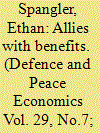| Srl | Item |
| 1 |
ID:
162546


|
|
|
|
|
| Summary/Abstract |
This paper examines the security relationship between the US and Europe, focusing on potential spillin effects of US military expenditures on European demand for military expenditures during the early twenty-first century. The goal is to test whether or not European states view US expenditures as a complement or as a substitute to their own military expenditures. Past work in this area has found mixed results concerning the effect of US military expenditures, but focus strictly on the spillins within a formal alliance, specifically NATO, and use a time series dominated by Cold War dynamics. This study differentiates itself by accounting for both US total military expenditures and its regional expenditures through incorporation of US military base and personnel deployments across Europe. Additionally, this paper uses government revenue in its estimation to mitigate potential endogeneity. Findings using Arellano–Bond dynamic panel analysis suggest that there is a strong probability of substitution among European states.
|
|
|
|
|
|
|
|
|
|
|
|
|
|
|
|
| 2 |
ID:
184061


|
|
|
|
|
| Summary/Abstract |
This paper establishes a new method of estimating public dissent that is both cost-effective and adaptable. Twitter allows users to post short messages that can be viewed and shared by other users, creating a network of freely and easily observable information. Drawing data directly from Twitter, we collect tweets containing specified words and phrases from citizens voicing dissatisfaction with their government. The collected tweets are processed using a regular expression based algorithm to estimate individual dissent; which is aggregated to an overall measure of public dissent. A comparative case study of Canada and Kenya during the summer of 2016 provides proof of concept. Controlling for user base differences, we find there is more public dissent in Kenya than Canada. This obvious, but necessary, result suggests that our measure of public dissent is a better representation of each country’s internal dynamics than other more sporadic measures. As a robustness check, we test our estimates against real-world civil unrest events. Results show our estimates of public dissent are significantly predictive of civil unrest events days before they occur in both countries.
|
|
|
|
|
|
|
|
|
|
|
|
|
|
|
|